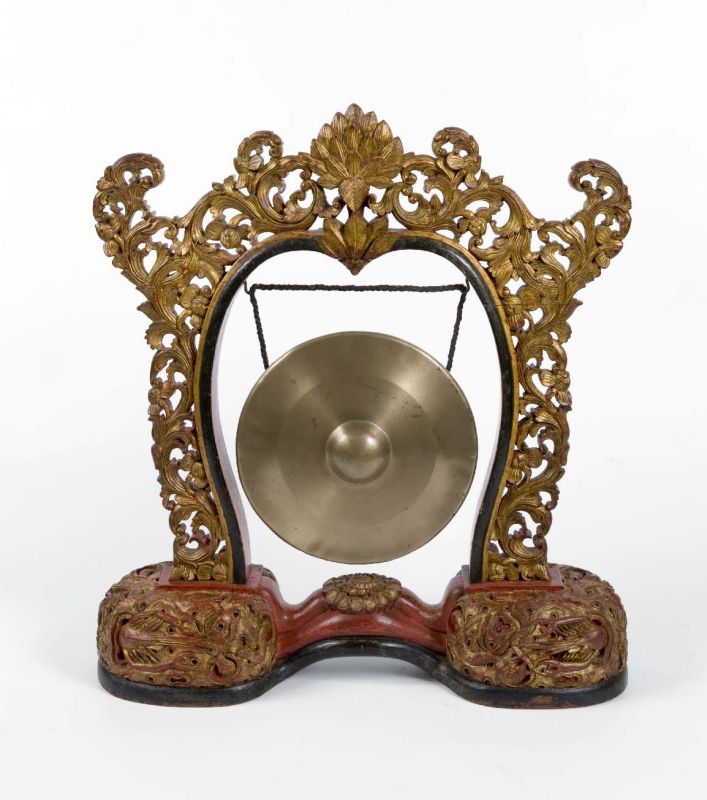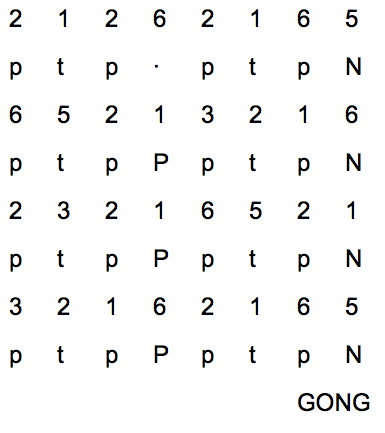|
Kempul
A kempul is a type of hanging gong used in Indonesian gamelan. The kempul is a set of pitched, hanging, knobbed gongs, often made of bronze, wood, and cords. Ranging from 19 cm to 25,4 cm (7 to 10 inches) in diameter, the kempul gong has a flat surface with a protruding knob at the center and is played by hitting the knob with the "soft end of a mallet." "The wooden mallet used has a ball shape head with heavy padding on a short wooden handle. The number of kempul gongs present in a gamelan ensemble varies but, "although there can be two to ten kempul on one separate rack, it is common to have five kempul hanging on the same rack as the Gong ageng and gong siyem" (two larger gongs). Kempul in music "Generally, the instruments in a gamelan orchestra may fall into the following three functional categories: # Instruments that delineate the structure of the piece; # Instruments that guide temporal flow of the music; # Instruments that carry melodies in both simple and ... [...More Info...] [...Related Items...] OR: [Wikipedia] [Google] [Baidu] |
Gamelan
Gamelan () ( jv, ꦒꦩꦼꦭꦤ꧀, su, ᮌᮙᮨᮜᮔ᮪, ban, ᬕᬫᭂᬮᬦ᭄) is the traditional ensemble music of the Javanese, Sundanese, and Balinese peoples of Indonesia, made up predominantly of percussive instruments. The most common instruments used are metallophones played by mallets and a set of hand-played drums called '' kendhang/Kendang'', which register the beat. The kemanak (a banana-shaped idiophone) and gangsa (another metallophone) are commonly used gamelan instruments in Bali. Other instruments include xylophones, bamboo flutes, a bowed instrument called a ''rebab'', a zither-like instrument '' siter'' (in Javanese ensemble) and vocalists named '' sindhen'' (female) or ''gerong'' (male).Sumarsam (1998)''Introduction to Javanese Gamelan'' Middletown. Although the popularity of gamelan has declined since the introduction of pop music, gamelan is still commonly played in many traditional ceremonies and other modern activities in Indon ... [...More Info...] [...Related Items...] OR: [Wikipedia] [Google] [Baidu] |
Gongs
A gongFrom Indonesian and ms, gong; jv, ꦒꦺꦴꦁ ; zh, c=鑼, p=luó; ja, , dora; km, គង ; th, ฆ้อง ; vi, cồng chiêng; as, কাঁহ is a percussion instrument originating in East Asia and Southeast Asia. Gongs are a flat, circular metal disc that is typically struck with a mallet. They can be small or large in size, and tuned or can require tuning. The earliest mention of gongs can be found in sixth century Chinese records, which mentioned the instrument to have come from a country between Tibet and Burma. The term ''gong'' ( jv, ꦒꦺꦴꦁ) originated in the Indonesian island of Java. Scientific and archaeological research has established that Burma, China, Java and Annam were the four main gong manufacturing centres of the ancient world. The gong found its way into the Western World in the 18th century, when it was also used in the percussion section of a Western-style symphony orchestra. A form of bronze cauldron gong known as a resting ... [...More Info...] [...Related Items...] OR: [Wikipedia] [Google] [Baidu] |
Gong Siyem
The gong ageng (or gong gedhe in Ngoko Javanese, means large gong) is an Indonesian musical instrument used in the Javanese gamelan. It is the largest of the bronze gongs in the Javanese and Balinese gamelan orchestra and the only large gong that is called ''gong'' in Javanese.Lindsay, Jennifer (1992). ''Javanese Gamelan'', p.10-11. . "The largest phrase of a gamelan melody is marked by the deepest sounding and largest instrument, the large gong or ''gong ageng''....The ''gong ageng'' is made of bronze..." Unlike the more famous Chinese or Turkish tam-tams, Indonesian gongs have fixed, focused pitch, and are dissimilar to the familiar crash cymbal sound. It is circular, with a conical, tapering base of diameter smaller than gong face, with a protruding polished boss where it is struck by a padded mallet. Gongs with diameter as large as have been created in the past, but gongs larger than about are more common especially to suit the budget of educational institutions.Wasisto ... [...More Info...] [...Related Items...] OR: [Wikipedia] [Google] [Baidu] |
Kethuk
The kempyang and ketuk are two instruments in the gamelan ensemble of Indonesia, generally played by the same player, and sometimes played by the same player as the kenong. They are important beat-keepers in the colotomic structure of the gamelan. Depending on the structure, they play different, repeating patterns every gongan. Not all structures use the kempyang, but the kempyang is never played without the ketuk. They are shaped like bonang, but are generally placed in their own frame (''rancak''). The kempyang is pitched higher (about one octave, although it depends if they are in the pelog or slendro set. Both have a central boss like the bonang, but the kempyang has a rounder top (like the higher bonangs), while the ketuk has a flat top (like the lower bonangs). In the common numerical notation, kempyang strokes are marked by "-" while the ketuk is marked by "+". The ketuk pattern is used to classify longer gendhing types, where it refers to the number of ketuk strokes ... [...More Info...] [...Related Items...] OR: [Wikipedia] [Google] [Baidu] |
Kenong
The Kenong is a musical instrument of Indonesia used in the gamelan. It is a kind of gong and is placed on its side. It has the same length and width. Thus, it is similar to the bonang, kempyang, and ketuk, which are also cradled gongs. Kenongs are generally much larger than the aforementioned instruments. However, the kenong has a considerably higher pitch. Its sound stands out because of its unique timbre. The kenong sticks are taller than that of the bonang. The kenong is sometimes played by the same player as the kempyang and ketuk. Most of the instruments in the gamelan 'family'. are originally from Java, Indonesia but spread to Southeast Asia. The kenong usually has a specific part in the colotomic structure of the gamelan, marking off parts of a structure smaller than a gongan (the space between each strike of the gong). The interval of each part between strikes of a kenong is called a . In a fast, short structure these can only last a second or so; in a longer gen ... [...More Info...] [...Related Items...] OR: [Wikipedia] [Google] [Baidu] |
Mallet
A mallet is a tool used for imparting force on another object, often made of rubber or sometimes wood, that is smaller than a maul or beetle, and usually has a relatively large head. The term is descriptive of the overall size and proportions of the tool, and not the materials it may be made of, though most mallets have striking faces that are softer than steel. Mallets are used in various industries, such as upholstery work, and a variety of other general purposes. It is a tool of preference for wood workers using chisels with plastic, metal, or wooden handles, as they give a softened strike with a positive drive. * Wooden mallets are usually used in carpentry to knock wooden pieces together, or to drive dowels ,chisels and to apply pressure on joints. A wooden mallet will not deform the striking end of a metal tool, as most metal hammers would. It is also used to reduce the force driving the cutting edge of a chisel, giving better control. Hardwood mallets are also use ... [...More Info...] [...Related Items...] OR: [Wikipedia] [Google] [Baidu] |
Idiophone
An idiophone is any musical instrument that creates sound primarily by the vibration of the instrument itself, without the use of air flow (as with aerophones), strings (chordophones), membranes (membranophones) or electricity ( electrophones). It is the first of the four main divisions in the original Hornbostel–Sachs system of musical instrument classification (see List of idiophones by Hornbostel–Sachs number). The early classification of Victor-Charles Mahillon called this group of instruments ''autophones''. The most common are struck idiophones, or concussion idiophones, which are made to vibrate by being struck, either directly with a stick or hand (like the wood block, singing bowl, steel tongue drum, triangle or marimba) or indirectly, with scraping or shaking motions (like maracas or flexatone). Various types of bells fall into both categories. A common plucked idiophone is the Jew's harp. According to Sachs, idiophones Etymology The word is from Ancient G ... [...More Info...] [...Related Items...] OR: [Wikipedia] [Google] [Baidu] |
Slendro
Slendro ( jv, ꦱ꧀ꦭꦺꦤ꧀ꦢꦿꦺꦴ, ban, slendro, translit=Sléndro) ( su, salendro, translit=Saléndro) is one of the essential tuning systems used in gamelan instruments that have pentatonic scale. Based on Javanese mythology, the Slendro Gamelan tuning system is older than the '' pélog'' tuning system. Etymology Slendro is a Javanese term for one of the scales in gamelan. It is derived either from " Sailendra", the name of the ruling family in the eighth and ninth centuries when Borobudur was built, or from its earlier being given by the god Sang Hyang Hendra. History The origin of the ''slendro'' scale is unknown. However the name ''slendro'' is derived from Sailendra, the ancient dynasty of Mataram Kingdom in Central Java, and also Srivijaya. The ''slendro'' scale is thought to be brought to Srivijaya by Mahayana Buddhists from Gandhara of India, via Nalanda and Srivijaya from there to Java and Bali. It is similar to scales used in Indian and Chinese musi ... [...More Info...] [...Related Items...] OR: [Wikipedia] [Google] [Baidu] |

_Kempul_TMnr_4423-2.jpg)



